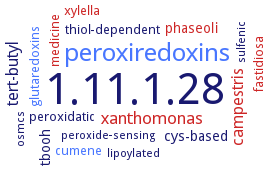1.11.1.28: lipoyl-dependent peroxiredoxin
This is an abbreviated version!
For detailed information about lipoyl-dependent peroxiredoxin, go to the full flat file.

Word Map on EC 1.11.1.28 
-
1.11.1.28
-
peroxiredoxins
-
xanthomonas
-
campestris
-
tert-butyl
-
phaseoli
-
tbooh
-
cys-based
-
xylella
-
peroxidatic
-
cumene
-
medicine
-
thiol-dependent
-
fastidiosa
-
glutaredoxins
-
osmcs
-
peroxide-sensing
-
sulfenic
-
lipoylated
- 1.11.1.28
- peroxiredoxins
- xanthomonas
- campestris
-
tert-butyl
- phaseoli
-
tbooh
-
cys-based
- xylella
-
peroxidatic
- cumene
- medicine
-
thiol-dependent
- fastidiosa
- glutaredoxins
-
osmcs
-
peroxide-sensing
-
sulfenic
-
lipoylated
Reaction
Synonyms
AhpC, AhpCD, AhpD, ahpD1, ahpD2, alkyl hydroperoxide reductase, alkyl hydroperoxide reductase subunit C, EC 1.11.1.15, MfOhr, Ohr, Organic hydroperoxide resistance, organic hydroperoxide resistance protein, peroxiredoxin AhpC, peroxiredoxin AhpD
ECTree
Advanced search results
Systematic Name
Systematic Name on EC 1.11.1.28 - lipoyl-dependent peroxiredoxin
Please wait a moment until all data is loaded. This message will disappear when all data is loaded.
lipoyl:hydroperoxide oxidoreductase
Peroxiredoxins (Prxs) are a ubiquitous family of antioxidant proteins. They can be divided into three classes: typical 2-Cys, atypical 2-Cys and 1-Cys peroxiredoxins [2]. The peroxidase reaction comprises two steps centred around a redox-active cysteine called the peroxidatic cysteine. All three peroxiredoxin classes have the first step in common, in which the peroxidatic cysteine attacks the peroxide substrate and is oxidized to S-hydroxycysteine (a sulfenic acid) (see {single/111115a::mechanism}). The second step of the peroxidase reaction, the regeneration of cysteine from S-hydroxycysteine, distinguishes the three peroxiredoxin classes. For typical 2-Cys Prxs, in the second step, the peroxidatic S-hydroxycysteine from one subunit is attacked by the 'resolving' cysteine located in the C-terminus of the second subunit, to form an intersubunit disulfide bond, which is then reduced by one of several cell-specific thiol-containing reductants completing the catalytic cycle. In the atypical 2-Cys Prxs, both the peroxidatic cysteine and its resolving cysteine are in the same polypeptide, so their reaction forms an intrachain disulfide bond. The 1-Cys Prxs conserve only the peroxidatic cysteine, so its regeneration involves direct interaction with a reductant molecule. Two types of lipoyl-dependent peroxiredoxins have been reported from bacteria. One type is the AhpC/AhpD system, originally described from Mycobacterium tuberculosis. In that system, AhpC catalyses reduction of the substrate, resulting in an intramolecular disulfide. AhpD then forms an intermolecular disulfide crosslink with AhpC, reducing it back to active state. AhpD is reduced in turn by lipoylated proteins. The second type, which has been characterized in Xylella fastidiosa, consists of only one type of subunit, which interacts directly with lipoylated proteins.


 results (
results ( results (
results ( top
top





